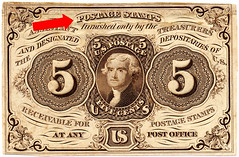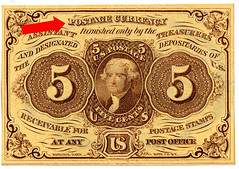
PREV ARTICLE
NEXT ARTICLE
FULL ISSUE
PREV FULL ISSUE
PREMIUMS PAID FOR POSTAGE AND FRACTIONAL CURRENCY
Jerry Fochtman submitted this response to an earlier E-Sylum item. Thanks!
-Editor


I'd like to respond to Peter Huntoon's query in the November 27th, edition of The E-Sylum. The question was based upon an exchange he was having with Fred Reed as to the premiums being advertised for the purchase of postage and fractional currency. Mr. Huntoon was seeking Treasury tables/etc. outlining a premium difference between postage and fractional currency, speculating that the premium was due to postage currency's value being used to meet customs duties whereby fractional currency could not be used for that purpose. While the Act of July 17, 1862 is often identified as the enabling act for the issuance of postage currency, this is incorrect. The Act itself only authorized postal 'stamps'. Samuel P. Chase and Francis E. Spinner creatively interpreted this as the means that allowed them to issue facsimiles of the current postal stamps as a method to provide for the commercial exchange of value in amounts of less than $1 (i.e. fractional monies). The use of 'stamps' to pay customs fees and duties is a continuation of earlier legislation related to revenue stamps and is reflected in this act as well. Because Chase/Spinner proposed the use of the 'stamps' as a basis for commerce involving fractional values less than $1, so did the relationship of using the first issue of postage currency to satisfy customs taxes. This is reflected in the engraving on the notes themselves. When the Act of July 17, 1862 took effect on August 1st, 1862 it also made the manufacture, issue, circulation or use of other obligations for value less than one dollar unlawful and included provisions for fines and jail penalties. So effectively merchants, banks, etc. were facing these fines and penalties yet had nothing else to facilitate commerce in amounts less than $1. The first issuance of the new postal currency was through an Army Paymaster, on August 21st, 1862. The direct release to the general public began about 2 weeks later, or in early September, 1862. (I've seen a newspaper report of this but have not been successful in relocating it.) However, the volume of available notes was insufficient to meet the demands. The sheets printed and delivered from the bank note companies were being hand-cut by Treasury staff, which was time- consuming. As such, private scrip and postage stamps continued to circulate. It wasn't until late December, 1862 when the National Currency Bureau's output had reached upwards to $100,000 a day did the demand begin to lessen and the use of private scrip rapidly disappeared. The demand for the new fractional currency issued by the Treasury was driven primarily by two factors. First were the obvious penalties and fines associated with the use of the privately issued scrip. But more importantly, there also was the public's fear that the private scrip would become worthless overnight - the merchant/issuer would no longer honor it due to the fines and penalties. So there was significant public pressure to exchange what they had and to transact with merchants using only the new Treasury issued postage currency. In turn, merchants couldn't keep up with their customer's needs and the banks couldn't obtain sufficient quantities from the Treasury to satisfy the merchants. Advertisements began to appear whereby merchants and even individuals would offer a premium over face value for quantities of the new postage currency. Merchants needed the new currency to handle their commercial needs as well as the demands for it in exchange to retire the private scrip they had previously issued. Individuals wanted it because they felt it would hold value as oppose to private scrip issued by a merchant that could go out of business. Gold and silver coinage had long since disappeared and copper was also becoming scarce as people had begun hoarding it as well. (There's an interesting story of a New York merchant whose 1st floor fell into the basement of the building due to the weight of all the coin they had hoarded... but I digress.) While indeed the postage currency was and could be used for payment of customs, the commercial need and the concern as to the loss of value of the existing scrip was the main driving force behind the offer of premiums for the new postage currency. Postage Currency itself was actually never authorized by Congress. It was not until the Act of March 3rd, 1863, when Congress actually authorized the issuance of 'fractional currency'. In doing so the act explicitly did not authorized it to be accepted for payment of customs duties. Lucius Chittenden, Register of the Treasury during the Civil War, wrote an article for the "Harper's New Monthly Magazine" (October, 1890; Vol. 81, No. 485; page 699) entitled "New Moneys of Lincoln's Administration". It gives some interesting insight into the government's finances during this time as well as how Lincoln was troubled by coming up with the funds needed to support the war effort. The text of his article can be viewed at: www.yamaguchy.com/library/spaulding/chittend1890.html . Finally, when Francis Spinner was exploring the concept of producing notes of fractional amounts based upon the postage stamps of the time, the initial essay notes produced as examples were actually titled "Postage Stamps". (See example) These were shared with various people, including Montgomery Blair, Postmaster. However, the title was changed to "Postage Currency" in the final design. The extremely rare "Postage Stamps" essays may truly be the only form of the 1st issue that might be considered as duly authorized by the Act of July 17, 1862, and thereby can be used to satisfy customs fees.


To read the earlier article, see:
QUERY: PREMIUMS PAID FOR POSTAGE AND FRACTIONAL CURRENCY
(www.coinbooks.org/esylum_v14n49a11.html)
The Numismatic Bibliomania Society is a non-profit organization promoting numismatic literature. See our web site at coinbooks.org. To submit items for publication in The E-Sylum, write to the Editor at this address: whomren@gmail.com To subscribe go to: https://my.binhost.com/lists/listinfo/esylum All Rights Reserved. NBS Home Page Contact the NBS webmaster 
|